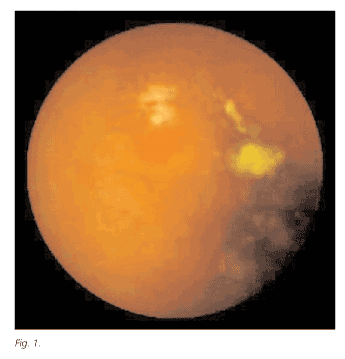Mi SciELO
Servicios Personalizados
Revista
Articulo
Indicadores
-
 Citado por SciELO
Citado por SciELO -
 Accesos
Accesos
Links relacionados
 Citado por Google
Citado por Google -
 Similares en
SciELO
Similares en
SciELO  Similares en Google
Similares en Google
Compartir
Revista Española de Enfermedades Digestivas
versión impresa ISSN 1130-0108
Rev. esp. enferm. dig. vol.96 no.11 Madrid nov. 2004
| PICTURES IN DIGESTIVE PATHOLOGY |
Ileal ulcers in a long-distance runner diagnosed by capsule endoscopy
J. Valle, J. Morillas1, M. J. Pérez-Grueso, J. M. Carrobles and J. L. Martínez-Potenciano
Hospital Virgen de la Salud. Toledo. 1Hospital Virgen de la Luz. Cuenca. Spain
A 31-year-old man committed to run twenty kilometres daily was admitted into the hospital two years ago because of severe microcytic anemia (Hb: 9.2 g/dL, MCV: 71 fl). He was not taking anti-inflammatory drugs, or any other medication. Upper gastrointestinal endoscopy, ileocolonoscopy and small bowel barium follow-through were all normal. The patient was discharged on oral iron supplements with a diagnosis of chronic iron deficiency anemia of unknown origin. Two months ago, the patient was admitted again because of melena for three days. He had no other gastrointestinal symptoms. Blood tests showed a mild normocytic anemia (Hb: 11.1 g/dL, MCV: 87.1 fl). An upper gastrointestinal endoscopy showed a short-segment Barrettacute;s esophagus without evidence of erosive esophagitis. A small-bowel follow-through was normal, and antiendomysial antibodies were negative. Capsule endoscopy showed two adjacent ulcers located in the proximal ileum (Fig. 1). After this diagnosis, the patient was advised to stop training. Nowadays, he is symptom-free and his hemoglobin level is 14.4 g/dL.
Up to 20% of long-distance runners develop hemoccult-positive stools after a marathon, and there have been reported cases of overt gastrointestinal bleeding. Decreased gastrointestinal blood flow has been postulated as the main mechanism underlying gastrointestinal lesions during strenuous exercise. To our knowledge, this is the first case of running-associated small bowel ulcers diagnosed by capsule endoscopy (1-3).
REFERENCES
1. Schwartz AE, Vanagunas A, Kamel PL. Endoscopy to evaluate gastrointestinal bleeding in marathon runners. Ann Intern Med 1990; 113: 632-3.
2. Ginard D, Gayá J, Bonét Ll, Sapiña A, Llompart A, Vaquer P, et al. Hemorragia digestiva en un corredor de larga distancia. Rev Esp Enferm Dig 1999; 91: 594-8.
3. Peters HPF, Bos M, Seebregts M, Akkermans LMA, van Berge Henegouwen GP, Bol E, et al. Gastrointestinal symptoms in long-distance runners, cyclist, and triathletes: prevalence, medication, and etiology. Am J Gastroenterol 1999; 94: 1570-81.











 texto en
texto en 



